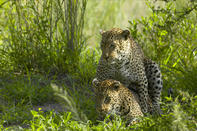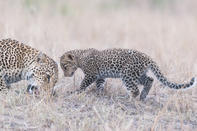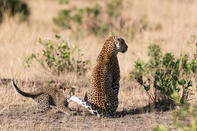Solitary and Territorial
Leopards are solitary animals except at times when females may be accompanied by their growing cubs. Both male and female leopards defend territories that are same-sex exclusive.

The size of the territory depends on the availability of prey and varies between 5 and 100 km² (usually about 15 km²). Females choose territories based on prey density and available den sites. Males select territories based on the availability of females.
Male leopards have larger territories than females and these encompass a number of female territories. In this way, the males can locate and mate with females as and when they enter oestrus (come into heat). They detect females both by chemical clues left behind in their urine and through the constant calling of a female seeking a mate.
Opposite sexes generally only remain in one another’s company for the period of courtship and mating. They may share kills during this time but the male plays no part in raising the cubs. Male leopards are also known as ‘toms’. When leopards do come together to mate, it is an intense affair lasting two to five days with copulations occurring every five to ten minutes.
Females are very flirtatious at this time even leaving their own territories to actively seek out a male or calling and marking incessantly to attract one to her. The end of a mating bout is marked by a vicious paw swat aimed at the male’s face. The female reels around in response to the painful extraction of the male’s barbed penis.
Gestation is rapid and cubs are born relatively undeveloped being completely helpless and blind (altricial). Female leopards can not afford to be weighed down by a pregnant belly for too long as this would affect their hunting ability. Instead, cubs continue to grow in a secret hiding place for six weeks and are suckled by the female for 3 months.
Altricial Cubs

Leopards are excellent mothers and will leave their cubs secreted away in dense bush or up a tree in order to hunt for food to which they will then lead their offspring.
They do this until the cubs are about nine and a half months old at which time they may accompany the mother on hunts executing their first kill at around 11 months old.
Leopards can not fend for themselves until they are at least a year old and the female will accommodate her cubs within the confines and protection of their territories for at least eighteen months, if not longer, and even tolerate hunting visits by newly independent sub-adults, which may not immediately be able to set up territories of their own. Where there are cases of females’ territories overlapping, it is most likely between female relatives. They tend not to use the overlapping part of the range at the same time however.
Play Time

Leopard cubs are left alone, although in hiding, for many hours while the adults hunt and patrol their territories. Whether on their own or in the company of siblings, these periods impulsively become times of play and exploration.
Play is a critical activity as during these sessions muscles are honed and skills learnt that will be required for survival and hunting ability later in life. It is also during these long waits that these small predators first experience the lifestyle of every carnivore – feast and famine. Leopards experience a high cub mortality of up to 50%.
Despite being hidden in heavy cover, caves or holes, young cubs are often found by other carnivores and killed. All mammalian predators kill one another’s offspring instinctively reducing competition.
Hyenas are a particular threat to leopards and in high numbers have the advantage over the individually powerful cat.
By Megan Emmett